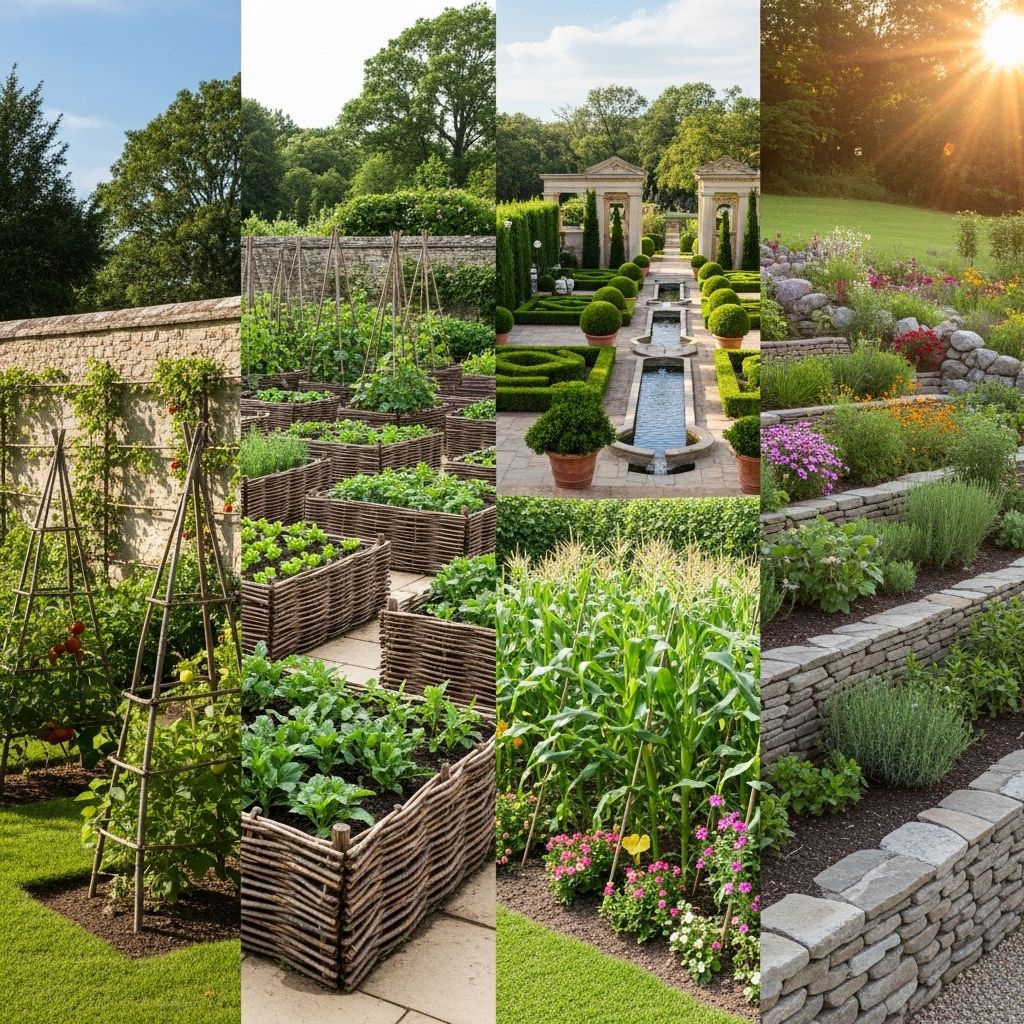5 Ancient Gardening Methods For Thriving Modern Gardens
Time-tested tips boost soil health, conserve water, and create vibrant outdoor spaces.

5 Ancient Gardening Methods That Work in the Modern Garden
As technology advances, many assume new is always better. However, the wisdom of ancient gardening often offers more sustainable, ecological, and soil-enhancing solutions than many modern practices. By re-examining time-tested strategies, we can nourish our soils and improve yields while reconnecting with nature and the land.
Why Ancient Gardening Methods Matter Today
Long before industrial fertilizers, pesticides, and plastics transformed agriculture, gardeners used clever methods that were less energy-intensive, more sustainable, and naturally fostered soil health. These methods were intricately tied to local environments and cultures, and offer us invaluable ways to create resilient, regenerative gardens for the future.
This article explores five ancient techniques from around the world, each with deep roots and ongoing relevance.
1. Clay Pot Irrigation: Passive Watering with Ollas
Ollas are unglazed clay pots buried in the soil near plants. These vessels have been used for millennia in regions like China and North Africa, providing a passive irrigation system that conserves water and keeps soil moist.
- The ollas are filled with water, which seeps slowly through the porous clay, directly hydrating plant roots.
- This method reduces surface evaporation and drastically cuts irrigation waste, making it especially valuable in arid climates.
- No electricity or complex systems needed—an easy, low-tech tool for sustainable gardens.
- Ollas should be removed in freezing climates for winter, replaced by mulch to maintain moisture.
In contemporary usage, gardeners report impressive water savings and healthier crops thanks to the steady moisture ollas provide. Modern versions are sometimes shaped for specific crops or garden layouts, but the principle remains unchanged.
Tip
Use mulch around ollas to further reduce water loss and help insulate roots.
2. Hotbeds: Heat from Decomposition
Hotbeds are a centuries-old method for generating heat using decomposing organic matter, allowing gardeners to start crops earlier and boost production.
- By layering manure, straw, and other organic matter, gardeners create beds that generate warmth as the materials break down.
- Records date back to Roman times: Emperor Tiberius’ gardeners used hotbeds to grow vegetables out of season.
- Hotbeds provide a warmed, protected environment that advances germination and growth.
- This strategy can substitute for heated greenhouses, requiring only organic inputs and basic construction.
Today, modern gardeners use hotbeds to overcome ‘the hungry gap’ in spring, germinate thousands of seedlings, and enable transplanting or even winter cropping. The heat produced can be significant, often sufficient for early tomatoes, lettuce, and other tender crops.
Insight
Creating hotbeds can be as simple as constructing a wooden frame, filling it with fresh manure and straw, and topping with soil for planting.
3. The Three Sisters: Companion Planting for Mutual Benefit
Three Sisters planting is a Native American tradition that combines corn, beans, and squash in a single mound, using each crop’s strengths to support the others.
- Corn grows tall and acts as a natural trellis for beans.
- Beans climb the corn and fix nitrogen in the soil, which benefits the other two plants.
- Squash creeps and spreads at the base, shading the soil, suppressing weeds, and retaining moisture.
The Three Sisters system exemplifies how companion planting enhances biodiversity, soil fertility, and yields. It also minimizes pest pressure while maximizing use of space—a principle still applied today in companion planting charts and polycultures throughout ecological gardening.
| Plant | Role | Benefits Provided |
|---|---|---|
| Corn | Trellis | Supports beans, creates structure |
| Beans | Nitrogen Fixer | Feeds soil, improves yields |
| Squash | Groundcover | Suppresses weeds, conserves moisture |
4. Mulching and Soil Building: Nature’s Blanket
Mulching is one of the oldest soil improvement strategies. Ancient gardeners—even those in arid landscapes—applied straw, leaves, or even animal manure atop the earth to:
- Retain moisture by reducing evaporation from the soil surface.
- Suppress weed growth and minimize competition for nutrients.
- Encourage soil life, as the mulch decomposes and feeds beneficial microbes and worms.
- Build organic matter, enhancing overall soil structure and fertility.
This simple method is still used worldwide, from rice paddies in Asia to market gardens in Europe. Whether straw, wood chips, leaves, or grass clippings, mulching not only mimics nature’s cycles but helps amend poor soils over time. Mulch is also critical for managing soil temperature and erosion.
5. Natural Pest Control: Harnessing Biodiversity
Before synthetic pesticides, ancient communities developed diverse strategies to keep crops healthy:
- Encouraging predatory insects and birds by planting flowers or maintaining hedgerows.
- Rotating crops and planting mixtures to disrupt pest lifecycles.
- Using traps or barriers—such as sticky tree bands or plant-based repellents.
- Interplanting aromatic herbs, onions, or garlic to repel insect pests naturally.
These strategies promote a diverse ecosystem where pests are less able to establish large populations. Modern organic fighters, such as neem oil or diatomaceous earth, echo ancient solutions, but the principle is the same: healthy, diverse gardens are naturally resilient.
Integrating Ancient Wisdom into Your Modern Garden
Adopting ancient techniques requires a close look at your own landscape, climate, and available resources. Consider:
- Climate—are you in a dry region suited for clay pot irrigation?
- Soil type—will a hotbed boost warmth and nutrients for early crops?
- Available space and crops—could companion planting like the Three Sisters work for you?
- Existing weeds and pests—will mulching or plant diversity help manage them?
- Time and labor—some methods, such as setting up hotbeds or harvesting mulch, require regular effort but pay off over seasons.
Experimenting with these techniques not only increases yields and resilience but also fosters a deeper appreciation of gardening’s history and connection to the land.
Comparison Table: Ancient Methods & Modern Benefits
| Ancient Method | Origin | Main Modern Benefit | Best Used For |
|---|---|---|---|
| Ollas (Clay Pot Irrigation) | China & North Africa | Water conservation | Arid climates, root crops, edible gardens |
| Hotbeds | Roman Empire | Season extension | Early starts, cold regions, intensive vegetable growing |
| Three Sisters Planting | Native America | Biodiversity, soil health | Polyculture beds, sustainable cropping |
| Mulching | Global | Soil improvement | Water retention, weed control, fertility building |
| Natural Pest Control | Global | Reduced chemicals | Healthy gardens, integrated pest management |
Frequently Asked Questions (FAQs)
Q: Can ancient gardening methods be used in container gardens or small urban plots?
A: Yes, practices like clay pot irrigation and mulching work very well in containers and raised beds. Companion planting techniques can also be adapted for small spaces with planter groupings.
Q: Are hotbeds practical for beginner gardeners?
A: Hotbeds can be built with simple materials and basic know-how, but they do require regular monitoring. Many beginners start with smaller, manageable frames and expand as skills develop.
Q: Is companion planting effective for pest control and higher yields?
A: Companion planting, as exemplified by the Three Sisters, effectively enhances soil fertility, pest resistance, and yields. Diversity is key to a healthy, productive garden ecosystem.
Q: What is the best ancient method for conserving water?
A: Clay pot irrigation (ollas) is one of the most effective ancient techniques for water conservation, ideal for dry areas or water-sensitive crops.
Q: Do I need special soil for mulching or clay pot irrigation?
A: No, these methods can be used on a variety of soil types, but adjusting mulch type or olla placement may enhance results in sandy, clay, or loamy soils.
Q: How can I learn more about ancient gardening?
A: Many gardening books, community gardens, and online resources provide practical guides and instruction on integrating ancient techniques.
Conclusion: Cultivating with Ancient Wisdom
Gardening need not rely exclusively on modern technology or chemicals. By drawing inspiration from the past, we can create gardens that are ecological, resilient, and rewarding, sustaining both plants and the planet. Whether you are a beginner or an experienced gardener, ancient methods offer surprisingly powerful tools for health, abundance, and connection.
References
Read full bio of Anjali Sayee












